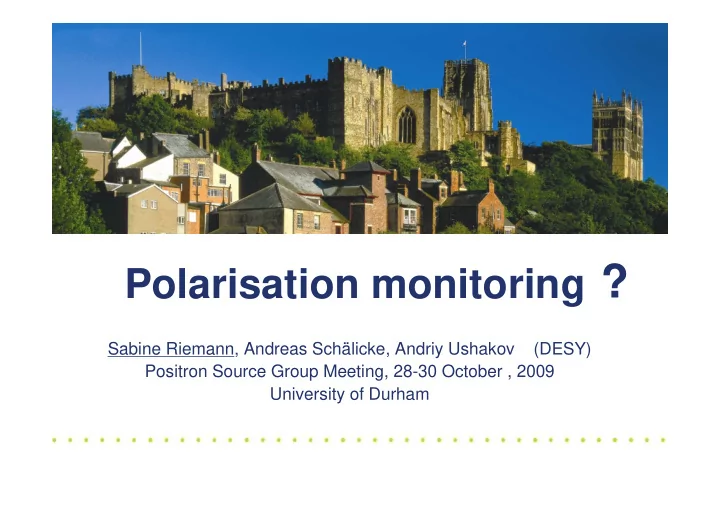

? Polarisation monitoring Sabine Riemann, Andreas Schälicke, Andriy Ushakov (DESY) Positron Source Group Meeting, 28-30 October , 2009 University of Durham
Outline Polarization measurement /monitoring near the sources : FAQ in discussions about polarimetry: Why not measuring polarization in the DR? � � � � Need method sensitive to transverse polarisation Possibilities: – Touschek effect – synchrotron radiation 2 Polarization monitoring? PS Meeting, Durham 2009
Touschek effect • particles in circulating bunch execute transverse betatron oscillations • transverse velocities statistically distributed • Coulomb scattering of charged particles � � � transfer transverse momenta to longitudinal � momenta (factor ~ γ γ γ γ in lab frame) – particles lost • First observation by Touschek (1963) by observation of beam lifetime in ADA ring • can also happen with intense beams of low emittance 3 Polarization monitoring? PS Meeting, Durham 2009
Touschek effect and polarization Intra-beam scattering � Moller cross section ρ ρ 1 4 3 σ d P P ~ − − 1 2 2 sin 4 sin 2 sin 2 Ω γ θ θ θ d � Touschek effect ~ P 2 � Polarized beams: less Touschek-radiation Effect is used to measure polarization differences Best sensitivity between polarized and unpolarized beam � Observation of depolarization − N N 2 unpol pol ∆ ∝ P N unpol 4 Polarization monitoring? PS Meeting, Durham 2009
• Experimental setup VEPP-4M (Blinov et al., EPAC 2002) Method used to detect forced depolarization Depolarization � Jump in counting rate of Touschek electrons 5 Polarization monitoring? PS Meeting, Durham 2009
Size of the polarization dependent effect: few percent-level VEPP-4M: Nikitin, Nikolaev, BINP, EPAC 2006 Proceedings Jump of counting rate for Touschek electrons vs ratio horizontal /vertical beam size 6 Polarization monitoring? PS Meeting, Durham 2009
Touschek effect to monitor polarization Relative polarization measurement: – Method is non-destructive, simple � ∆ ∆ ∆ ∆ P 2 changed by – variation from P=0.8 to P=0.6 � � � factor 1.8 – Observe large polarization differences for ↓ ↓ ↓ and ↓ ↑ ↑ ↑ ↑ orientation But: – rates depend on beam sizes, #particles/bunch,… � Need very stable beams – we do not expect serious depolarization or large ↓↑ differences ↓↑ ↓↑ ↓↑ � Method not sensitive enough – Effect for positrons (P 2 =0.09) smaller than for electrons (P 2 =0.64) 7 Polarization monitoring? PS Meeting, Durham 2009
• One should check whether BPMs can be used to detect asymmetries between ↓ and ↑ or depolarization effects • But most likely the statistical fluctuations in a linear machine are larger than effect to be measured 8 Polarization monitoring? PS Meeting, Durham 2009
Synchrotron radiation Bondar, Saldin: NIM 195(1982)577, Belomestnykh et al., NIM 227(1984)173 • Measure the tiny spin dependent component of SR • Small differences in spectra of high energy photons emitted from polarized or unpolarized beams 2 ρ ϖ 2 ( ) S e ϖ 2 2 4 & = γ W e v 2 6 2 & & = γ × ⋅ W S v v v 0 3 m ρ ( ) ρ & / = × γ v e v H m • SR from polarized beam more intense than from unpolarized, relative difference is δ = ⋅ γ ⋅ y P ω 3 2 γ eH = y ω = C ω 2 mc C δ ~ H γ Better sensitivity for ω >> ω C, • effect is small, ~10e-4… 10e-3 spin effect depends on sign � reversal of H to reduce syst. effects • 9 Polarization monitoring? PS Meeting, Durham 2009
Measurement of spin dependence at VEPP • Smallness of effect � stability of – Beam position – Beam energy – Beam intensity • 2 bunches chosen to observe relative variations when one is depolarized • Use snake located in straight section to create SR snake Field distribution • Detector: scintillator with Pb plate to eliminate photons with low ω PM 10 Polarization monitoring? PS Meeting, Durham 2009
Results • ‘equalize’ bunches • Measure counting rates N1 and N2 in the detector for the bunches when they pass the snake • One bunch is depolarized at time a and b 11 Polarization monitoring? PS Meeting, Durham 2009
To obtain the effect with ILC beam needs extremely high stability � not suited to monitor or measure the polarization 12 Polarization monitoring? PS Meeting, Durham 2009
For comparison: Compton polarimeter Measurement of transverse polarization: • Cross section and luminosity are the same as for long. Polarization • Small asymmetry, 1…2% • More complicated detector since E deposition and angular distribution position have to be measured Details see Alexander,Starovoitov, LC-M-2007-014, 2007 13 Polarization monitoring? PS Meeting, Durham 2009
Summary • Advantage: presented methods work with transverse beam polarisation, not expensive, non-destructive • Disadvantage: effects are very small • Use in linear machines would require extreme stability, otherwise statistical fluctuations are larger than effect These methods cannot replace the polarization measurement at the source 14 Polarization monitoring? PS Meeting, Durham 2009
• Experimental setup VEPP-4M (Blinov et al., EPAC 2002) – Method used to detect forced depolarization 15 Polarization monitoring? PS Meeting, Durham 2009
Recommend
More recommend